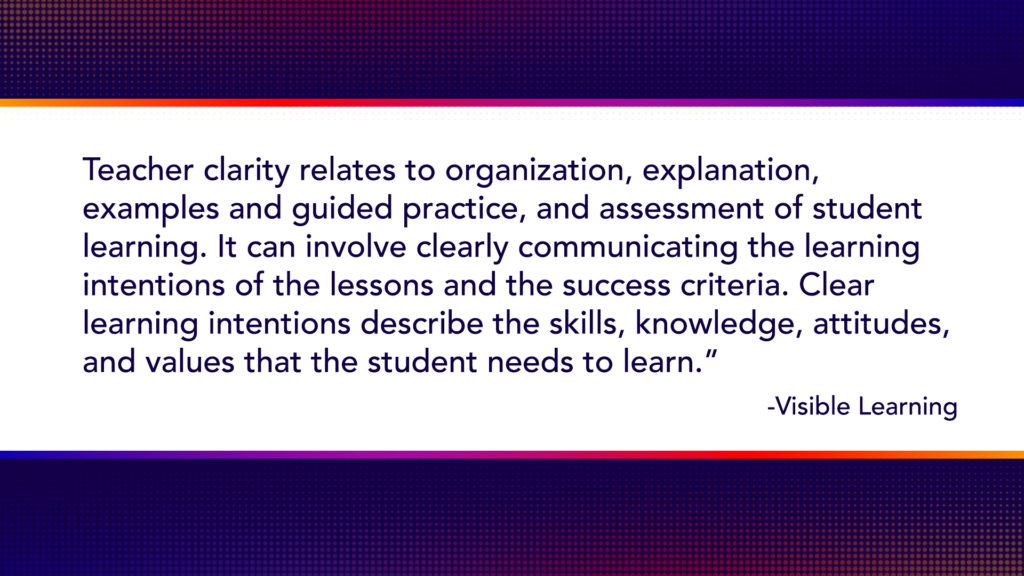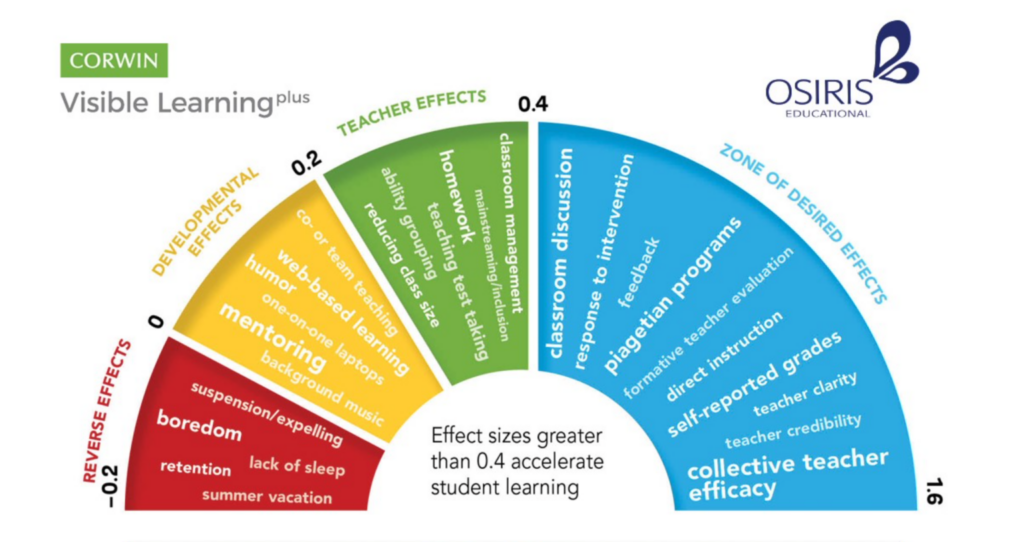“Clarity precedes success.”
— Robin S. Sharma, Author
As an educational leader, you are in an excellent position to help teachers increase the effectiveness of their instructional practice through formal or informal coaching. Whether you are a building leader crafting a weekly newsletter with instructional tips or a math coach sharing feedback with a teacher, a focus on teacher clarity can elevate student learning and as author Robin Sharma says, “Clarity precedes success.” Supporting teacher clarity, a research-based best practice, can help educators communicate important learning information to students. This clarity has been shown to increase student achievement which is a win for everyone! But what is teacher clarity?

Professor John Hattie of the University of Melbourne, Australia, has long researched performance indicators and evaluation in education. His research, Visible Learning, represents more than 25 years of work. Hattie and team examined and synthesized more than 1,850 meta-analyses from 108,000 studies involving 300 million students globally. They did research about research! Hattie wanted to know which teaching and learning variables were most important, so his team calculated a score or “effect size” for each method. The effect size was based on the positive impact to student learning. The average effect size was 0.4 which represented a year’s growth per year of schooling. Anything above 0.4 would have a greater positive effect on student learning.
Teacher clarity has a 0.85 effect size. (Corwin Visible Learning) It works to positively affect student learning by nearly 2x more than average.
So how can you support teacher clarity to elevate student learning as you lead and coach? Focus on sharing these five most commonly advised clarity concepts. Use the considerations to think about how you might apply each concept in your coaching and/or leadership. For example, you may decide to use these concepts and considerations to inform individual reflection (the teacher’s and your own), to set guidelines for peer feedback, or initiate a PLC discussion. Our favorite recommendations are as follows:
- Learning intentions should be derived from standards, and success criteria should be derived from learning intentions.
Considerations: Are you able to identify the links when you observe a lesson? How can you help teachers make better use of the standards in their planning? What questions can you ask teachers to increase their understanding and application of these concepts?
- Students can and should be involved in creating and using success criteria to reflect on their performance.
Considerations: Do you see teachers engaging learners in discussions about success criteria? Do lessons include a component which encourages students to self-reflect on the success criteria? What information or support can you provide the teacher to encourage implementation of these practices?
- Learning intentions, success criteria, and formative assessment must be linked.
Considerations: During coaching sessions or observations, is the teacher’s through line obvious to you? Are students also able to recognize it? How can you help teachers better align these components and communicate that alignment?
- The first step to finding or creating a formative assessment is identifying learning intentions and success criteria.
Considerations: Does the evidence teachers are asking for in formative assessments relate to the success criteria presented to students? How do formative assessments help students know where they are and move them forward in learning? How does the formative assessment help the teacher adjust and/or extend learning for all students?
- Teachers must communicate the learning intentions and success criteria in a variety of formats (verbally, in writing, in a checklist, etc.)
Considerations: Is each student in the classroom able to access the learning intentions and success criteria? Can the students tell coaches or observers what they are learning, why they are learning it, and how they will know when they’ve learned it? What other concepts might teachers need to know to ensure access (Universal Design for Learning, multimodal communication, accommodations, etc.)?
As you work to continually improve your daily leadership and coaching routines, keep teacher clarity front of mind to increase the likelihood of student and teacher success.
For further information on teacher clarity, review these additional resources. Please share them with colleagues as you see fit.
- San Bernardino City Schools has created a video model of teacher clarity. In the clip, the teacher walks through four steps to increase teacher clarity for her students.
- This student handout can help teachers improve communication during lessons to increase clarity and student success.
- In his blog, “Teacher Clarity, Even From a Distance,” Steve Ventura shares three methods for increased teacher clarity during online learning.
- Marine Freibrun provides an in-depth description of success criteria in her blog, “Using Success Criteria to Spark Motivation in Your Students.”
Looking for more research-based practices to implement in your professional practice as a leader or coach? Check out Course 5238: Practical Strategies for High-Impact Leadership to maximize your impact on the students and the teachers in your school.
Looking for a seamless way to support all of your teachers, all in one place? Our new EMPOWER Platform can provide your teachers with the clarity they need to perform for their students, with exemplar videos, opportunities for reflection and collaboration, instructional coaching tools, and data and reports.








